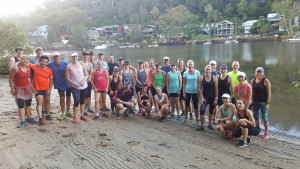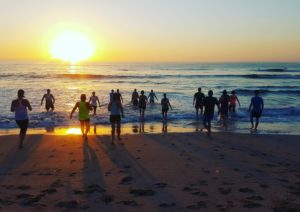Effects of Bludging Pre and Post Christmas (ie the Effects of Detraining)
/in Endurance, Running, Strength, Weight LossPlanning on taking it easy in the lead up to Christmas because it is the party season after all? Think again!
Cutting back or missing sessions will be detrimental to your strength and fitness – ‘Use it or Lose It‘ rings very true here!
If you back off before Christmas and then continue to do less over the Christmas break, you will potentially be detraining for up to 10 weeks! (it’s only 6 weeks until Christmas now and then most of you take a break or go on holidays after Christmas!)
The Facts
Detraining (short-term <4 weeks)
- Strength can be maintained without training up to 3-4 weeks, but is gradually lost thereafter (strictly speaking, you can temporarily lose strength before this, but it comes back so quickly during retraining that it doesn’t matter)
- Muscles start to atrophy (reduce in size) after 2-3 weeks, though gains usually come back quickly, at least in beginners. Trained athletes or those with a long training history may take longer to get back to where they left off.
- Endurance performance decreases by 4 to 25% after 3-4 weeks. That’s huge and hurts to get back. That hill that used to feel OK now feels like a mountain!
- VO2 max (your maximum oxygen consumption and an indicator of fitness) declines by 6 to 20% at around 4 weeks of detraining.
- Beginners can maintain endurance performance for at least 2 weeks without training, though recent VO2max gains can be reversed after 4 weeks. So if you are just starting out and feeling great then stop training over Christmas, you’ll be starting again from scratch. Remember that feeling when you first started? Do you really want to go back there?
- Muscle, strength, endurance, and fat gains/losses vary from person to person. Some will suffer more than others.
- Flexibility is reduced after 4 weeks of detraining by 7-30%
- Bed rest/immobilisation/sedentary behaviour (sunbaking?) speeds up muscle atrophy – sleeping in shrinks muscles!
- Lastly, your metabolism slows (due to loss of lean muscle and less activity) which will lead to weight gain.
Maintaining Gains and Fitness over a Break
- To maintain strength during 4+ weeks of detraining, train at least once per week (for beginners) and twice a week for more trained athletes.
- To maintain hypertrophy during 4+ weeks of detraining, train at least once per week (for beginners).
- To maintain endurance during 4+ weeks of detraining, you can lower training volume by 60 to 90%, training frequency by no more than 20-30% in athletes, but beginners can reduce it by 50 to 70%. Training intensity should be the same. Therefore, if you do less, it still needs to be a hard workout to be effective. The odd walk won’t cut it.
- If injured, use alternative training forms such as strength training (which can maintain some endurance performance) or underwater running, cycling or swimming.
So – if you are pondering taking it easy over the Christmas break, remember that being active should be a year long/life long habit, not something to stop and start. Something is better than nothing so even if its 30mins, just get out there and move each day over the break.
The #1 Habit You Should Have to Lose Weight
/in UncategorizedThe #1 Habit You Should Have to Lose Weight
We can all agree that a habit is anything you do regularly, but according to the definition used in psychology, a habit also needs to be done automatically — as in, without really thinking about it.
How to make exercise a HABIT
FIND PEOPLE TO SHARE YOUR WEIGHT LOSS AND FITNESS JOURNEY WITH
Coastal Classic Training Run Saturday 5th August 2017
/in UncategorizedClick here for the details regarding Saturday’s run.
The Importance of Electrolytes When Exercising
/in Endurance, Events, Nutrition, RunningSweating Much This Week???
With the current heat wave upon us and the fact that we are all continuing to exercise or train for upcoming events (which is great), we need to take a closer look at Electrolyte replacement to ensure that we can get the most out of our training and recovery.
What are electrolytes?
Electrolytes are important nutrients for our bodies as they play key roles in sending electrical impulses that influence our heart, muscles and nerves. They also play an important role in fluid balance and hydration in our cells, tissues, and our muscles. Lack of sufficient electrolytes can contribute to muscle cramps, delayed muscle soreness (DOMS) and spasms following exercise, and can contribute to headaches.
Symptoms of Electrolyte Imbalance
• dark urine (a sign of dehydration)
• irregular heartbeat
• fatigue
• lethargy
• convulsions or seizures
• nausea and/or vomiting
• bowel irregularities (including diarrhea and constipation)
• abdominal cramping
Where are Electrolytes Found?
Electrolytes include sodium, potassium, calcium, chloride and magnesium. Most often electrolytes can be found in foods but they can also be found in beverages such as coconut water and juices made from electrolyte-rich fruits and vegetables. Electrolytes cannot be consumed by drinking water as water lacks these important electrolytes.
Which Foods Contain Electrolytes?
Foods that are naturally higher in electrolytes include all plant-based foods, but particularly fruits and vegetables, and primarily those that are red, orange, and/or yellow. These fruits and vegetables not only contain a rich-source of potassium but are also good source of magnesium. Nuts, seeds, and beans are also a good source of magnesium and calcium, but are not rich sources of potassium and sodium. Green leafy vegetables can also be a good source of calcium and potassium.
Good sources of Potassium:
– Beans (white beans)
– Green leafy vegetables: spinach, chard, kale, beet leaves
– Potatoes
– Bananas
– Dried apricots
– Yellow Squash, butternut pumpkin and zucchini
– Avocados
– Red, yellow and orange fruits and vegetables: bananas, beetroots, oranges, capsicums.
– Coconut water
Good sources of natural Sodium:
– Celery
– Beetroot
– Bok choy/Pak Choy, Asian Greens
– Capsicums (red, yellow, orange)
I also don’t mind a bit of good old Aussie Vegemite which is high in sodium, as is table salt, however salt is added to many packaged foods so minimise the amount you use.
Magnesium
Magnesium supports bone and teeth development, nerve and muscle function and enzyme activation. Getting enough magnesium in your diet also protects you from high blood pressure, a factor that increases your risk of heart disease, and helps to combat osteoporosis. It is found in leafy green vegetables, nuts, cereals, beans and tomato paste. Magnesium cannot be stored in the body so if you are not getting enough in your diet consider a supplement. You need a small amount of magnesium daily, about 400 milligrams for men and 300 milligrams for women.
Calcium
The body uses calcium for bone and teeth formation, blood clotting, muscle and enzyme function and normal heart rhythms. Calcium is most commonly found in milk and milk products. It is also in meat, fish with bones such as salmon, sardines, eggs, fortified breakfast cereals, beans and certain fruits such as dried apricots and figs, and vegetables such as asparagus and leafy greens. Aim for at least 1,000 milligrams of calcium each day.
Good sources of Magnesium and Calcium
- Beans
- Nuts & seeds such as pumpkin and sunflower seeds, wholegrains and yoghurt (magnesium mainly)
- Almonds, cashews, sunflower & sesame seeds, brazil nuts and pine nuts (highest content)
- Green leafy vegetables (calcium) and wheat-based grains (magnesium)
Electrolytes Post-Exercise
When you sweat, you primarily lose potassium and sodium, therefore to replenish the electrolytes lost, you can make a juice made from red, yellow, and orange produce (for natural sodium) with some green leafy vegetables (for potassium) to help replenish. Coconut water is also a great source of both potassium and sodium and is lower in calories and sugars. Try mixing the fruit and veg in coconut water or just have on its own. For the most part, coconut water is also higher than most juices in electrolytes, and therefore can make for a great way to replenish electrolytes lost through sweat.
Pre or Post-Exercise?
If you are participating in a high intensity exercise or training when it is very hot and humid, it’s important to prepare your body with electrolytes prior to exercising. For most, it may be more beneficial to drink 500-600mls of an electrolyte-rich beverage such as coconut water or electrolyte-rich juice, prior to exercising instead of waiting until after the exercise session.
Pre-exercise, your body is more likely to benefit from a higher electrolyte beverage as you provide your body with sufficient electrolytes before losing them through sweat.
Post-exercise, the focus should be more on a protein-rich beverage to repair muscle damage due to the exercise session. Dairy products contain key electrolytes and are also a source of protein and carbohydrate.
You can also use Staminade, Gatorade or similar to increase your electrolyte intake before, during or after exercise, but these are higher in sugars unless you are using a sugar free product (not a bad thing if you also need more carbohydrate intake for energy). Other electrolyte sources that are great are Hammer Endurolytes (a capsule) that can be taken with water, or various effervescent tablets that can be added to a drink bottle from brands like GU, Hammer, High 5, Endura.
What About Water?
Though water does not contain a good source of electrolytes, it still plays an important role in hydration and should not be forgotten.



